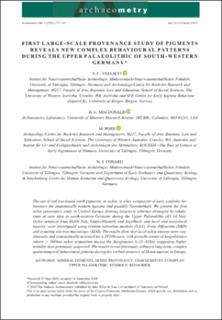| dc.contributor.author | Velliky, Elizabeth | |
| dc.contributor.author | Macdonald, Brandi lee | |
| dc.contributor.author | Porr, Martin | |
| dc.contributor.author | Conard, Nicholas j. | |
| dc.date.accessioned | 2021-04-26T08:44:46Z | |
| dc.date.available | 2021-04-26T08:44:46Z | |
| dc.date.created | 2020-10-07T13:51:02Z | |
| dc.date.issued | 2020 | |
| dc.identifier.issn | 0003-813X | |
| dc.identifier.uri | https://hdl.handle.net/11250/2739493 | |
| dc.description.abstract | The use of red iron‐based earth pigments, or ochre, is a key component of early symbolic behaviours for anatomically modern humans and possibly Neanderthals. We present the first ochre provenance study in Central Europe showing long‐term selection strategies by inhabitants of cave sites in south‐western Germany during the Upper Palaeolithic (43–14.5 ka). Ochre artefacts from Hohle Fels, Geißenklösterle and Vogelherd, and local and extra‐local sources, were investigated using neutron activation analysis (NAA), X‐ray diffraction (XRD) and scanning electron microscopy (SEM). The results show that local ochre sources were continuously and systematically accessed for c.29 500 years, with periodic events of long‐distance (about > 300 km) ochre acquisition during the Aurignacian (c.35–43 ka), suggesting higher mobility than previously suspected. The results reveal previously unknown long‐term, complex spatio‐temporal behavioural patterns during the earliest presence of Homo sapiens in Europe. | en_US |
| dc.language.iso | eng | en_US |
| dc.publisher | Wiley | en_US |
| dc.rights | Navngivelse 4.0 Internasjonal | * |
| dc.rights.uri | http://creativecommons.org/licenses/by/4.0/deed.no | * |
| dc.title | First large-scale provenance study of pigments reveals new complex behavioural patterns during the Upper Palaeolithic of southwestern Germany | en_US |
| dc.type | Journal article | en_US |
| dc.type | Peer reviewed | en_US |
| dc.description.version | publishedVersion | en_US |
| dc.rights.holder | Copyright 2020 The Authors | en_US |
| cristin.ispublished | true | |
| cristin.fulltext | postprint | |
| cristin.qualitycode | 2 | |
| dc.identifier.doi | 10.1111/arcm.12611 | |
| dc.identifier.cristin | 1837942 | |
| dc.source.journal | Archaeometry | en_US |
| dc.source.pagenumber | 173-193 | en_US |
| dc.identifier.citation | Archaeometry. 2021, 63(1): 173-193 | en_US |
| dc.source.volume | 63 | en_US |
| dc.source.issue | 1 | en_US |

